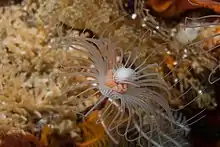Tubular hydroid
The tubular hydroid (Ectopleura crocea) is a species of hydroid cnidarian, and is found in temperate coastal waters. It is a member of the family Tubulariidae.[1]
| Tubular hydroid | |
|---|---|
 | |
| Scientific classification | |
| Kingdom: | Animalia |
| Phylum: | Cnidaria |
| Class: | Hydrozoa |
| Order: | Anthoathecata |
| Family: | Tubulariidae |
| Genus: | Ectopleura |
| Species: | E. crocea |
| Binomial name | |
| Ectopleura crocea (Agassiz, 1862) | |
Description
The tubular hydroid resembles a long-stemmed narrow-petalled flower. The stem is encased in a sheath. The polyps are pink or orange and white, with an outer ring of long tentacles. There are short tentacles surrounding the mouth rising from a cluster of yellow bead-like bunches of reproductive sporosacs.[2]
Distribution
This species is native to the Atlantic coast of North America, and also occurs in the Mediterranean Sea, the northeastern Atlantic Ocean, South Africa, Australia, New Zealand, and the west coast of North America.[3]
Ecology
Male and female sporosacs are on separate hydranths (feeding individuals) in the colony. These animals feed on tiny planktonic crustaceans.[4]
References
- "WoRMS - World Register of Marine Species - Ectopleura crocea (Agassiz, 1862)". www.marinespecies.org. Retrieved 2021-01-18.
- Branch, G.M., Branch, M.L, Griffiths, C.L. and Beckley, L.E. 2010. Two Oceans: a guide to the marine life of southern Africa. ISBN 978-1-77007-772-0.
- Fofonoff, P.W., Ruiz, G.M., Steves, B. and Carlton, J.T. 2003. National Exotic Marine and Estuarine Species Information System. http://invasions.si.edu/nemesis/ accessed 8 November 2013
- Naomi A. H. Millard, 1975. Monograph on the Hydroida of Southern Africa. Ann. S. Afr. Mus. 68:1-513
| Wikimedia Commons has media related to Ectopleura crocea. |